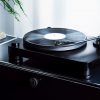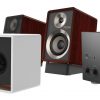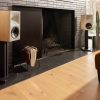Note: eCoustics is reader -supported and may make a commission if you purchase anything using the links on this site.
Earlier this month, Value Electronics and Dealerscope held a 2-day long projector shootout in Manhattan. Day one covered Ultra Short Throw (UST) projectors. Day two covered more traditional long throw “home theater” projectors, but these projectors were anything but traditional. Representing four manufacturers, powered by lasers, DLP, LCD, SXRD, D-ILA and a dozen more advanced acronyms, these projectors represented the cutting edge of consumer projection technology. Most of the models were introduced recently and represent these companies’ top performing projectors going into 2023.
With prices ranging from $4,000 to S28,000, the long throw projector competition was broken up into three distinct price ranges to ensure a relatively fair fight. The categories were: $4,000 to $7,000; $11,000-$16,000; and $25,000-$30,000. Spoiler Alert: JVC won the top spot in every price range. To be fair, the event was hosted by a dealer who happens to sell JVC projectors, but he also sells Sony, Epson and LG, the other three manufacturers represented. And while the hosts did bring four JVC projectors to the competition, they also brought three comparably priced Sony projectors which actually feature very similar technology (and very similar price points).
You can read our comprehensive coverage of the event here:
Long Throw Projector Shootout Reveals Top Performing Home Theater Projectors
How could one manufacturer dominate the competition so much? Two words: “black levels.” Yep, it’s still all about the black level or contrast. With all the progression toward more and more pixels (1080p -> 4K -> 8K), there’s still nothing that beats good old-fashioned inky black levels. And the JVC projectors have that in spades. Oh, and maybe two more words: “color saturation.” The JVC ran circles around competitive models from LG and Epson when it came time to color reproduction. It was, of course, significantly more expensive than those other two ($7,000 for the least expensive JVC projector vs. $5,000 for the Epson and $4,000 for the LG).
The only projector that really gave the “entry-level” JVC a run for its money was the Sony VPL-XW5000ES. The Sony projector lost the “budget” competition to the JVC by just 1/10 of a point and sells for a full $1,000 less. You wanna know what that one was good at? You guessed it. Black levels and color saturation.

In the midrange price category ($11,000-$16,000), the two JVC models sandwiched the Sony, taking first and third place while the Sony was in the middle in second place (but without enough mustard). Again, the Sony competitor put up a strong fight, finishing just a few tenths of a point behind the more expensive JVC and actually a few tenths above the less expensive JVC model.

In the final showdown round, the DLA-NZ9 ($25,999) eked out a win over the Sony VPL-XW7000ES ($27,999) with five tenths of a point separating the two. Here the JVC’s 8K pixel shift may have helped as the JVC projector scored noticeably higher for detail reproduction vs. the more expensive Sony projector (9.7 vs. 8.6). With 8K eShift, JVC is able to take a native 4K LCoS chip and upconvert the visible resolution four times to 8K resolution. It doesn’t support a native 8K source, but those extra pixels do help to smooth out the pixel structure while accentuating image detail from HD or 4K sources.

There was another factor that contributed to the projectors’ scores. The hosts chose not to do full professional calibration on the projectors, instead going with picture presets and defaults. They used a colorimeter and CalMan software to determine which color preset was closest to accurate and which color temperature setting was closest to D65 (6500 Kelvin) and used those settings on each projector. They also made small adjustments to brightness and contrast in order to make each projector perform as well as possible on test patterns for brightness and black level, such as PLUGE patterns. In some cases (like with the LG projector) raising the black levels to perform properly on the PLUGE tests resulted in a background black level that was really more like dark grey and couldn’t compete with the other three projectors on most content.

The other thing the hosts did was leave any default picture processing turned on. If it was turned on right out of the box, it stayed on. The team was trying to reproduce what an owner would see at home without a professional calibration or any detailed knowledge of how displays work. In some cases, this led to a little bit of “soap opera effect” on film-based material as the projectors applied their motion smoothing. In other cases (as with Sony’s “Reality Creation” processing) this resulted in excessive sharpness which led to unnatural looking outlines around images. This was more visible on some content than others and I would say it definitely had an impact on overall scores.
So what does this mean to a potential projector buyer or someone who already owns one? Well first of all, the JVC projectors really are top performers. They do pretty much everything well, some things (like black level) extremely well and nothing poorly. But Sony projectors are no slouch either. They beat the JVCs in overall bright levels and highlight details in several cases, which means they would probably make a better choice for use in brighter rooms. This higher luminance also means the Sony projectors can attain an exceptionally good overall color volume. The Sony projectors also reach deep into the inky blackness to create excellent contrast scores. But as an owner, you’ll probably want to look into the picture processing modes to see if they are helping or hurting the image overall.

Your best bet when buying a high-end projector is to be prepared to invest a little extra to get your projector calibrated. If you’re spending $4,000 or more on a projector, spend a few hundred dollars more to get the best possible performance out of it. More adjustments are available to professional calibrators than what you’ll find in the typical user settings. It may be that some of the projector’s video processing settings improve the picture when watching lower resolution (720p, 1080i, 1080p) material but do nothing to help (or may even hurt) when viewing pristine 4K HDR content from an Ultra HD Blu-ray Disc.
A good calibrator can work with you to set up a couple of different presets that you might select depending on what sort of content you’re watching, ambient room lighting, etc. It’s money well spent, not only for getting the highest possible performance from your gear, but also for the peace of mind knowing that all the virtual knobs and dials are in their rightful places as you sink into your recliner to the soothing sounds and images of the Death Star being annihilated one… more… time.
These JVC projectors are available from our affiliate partner ProjectorScreen.com in case you’d like to purchase one or find out more about each model. Here are the links:
> JVC DLA-NP5 ($6,999) – winner ($4000-$7000)
> JVC DLA-NZ8 ($15,999) – winner ($11,000-$16,000)
> JVC DLA-NZ9 ($25,999) – winner ($25,000-$30,000)
You May Also Like:
- 2022 Value Electronics UST Projector Shootout Results
- 2022 Value Electronics Long Throw Projector Shootout Results
- 2022 ProjectorScreen.com Laser TV Showdown Results






































